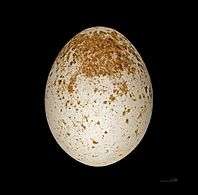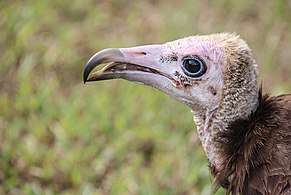Hooded vulture
| Hooded vulture | |
|---|---|
.jpg) | |
| in Gambia | |
| Scientific classification | |
| Kingdom: | Animalia |
| Phylum: | Chordata |
| Class: | Aves |
| Order: | Accipitriformes |
| Family: | Accipitridae |
| Genus: | Necrosyrtes Gloger, 1841 |
| Species: | N. monachus |
| Binomial name | |
| Necrosyrtes monachus (Temminck, 1823) | |
The hooded vulture (Necrosyrtes monachus) is an Old World vulture in the order Accipitriformes, which also includes eagles, kites, buzzards and hawks. It is the only member of the genus Necrosyrtes and is native to sub-Saharan Africa. It is a scruffy-looking, small vulture with dark brown plumage, a long thin bill, bare crown, face and fore-neck, and a downy nape and hind-neck. It typically scavenges on carcasses. Although it remains a common species in the lower region of Casamance, some areas of The Gambia, and Guinea-Bissau; other regions such as Dakar, Senegal show more than 85% losses in population over the last 50 years[2]. Threats include poisoning, hunting, and loss of habitat, and the International Union for Conservation of Nature has rated its conservation status as "critically endangered".
Description
The hooded vulture is a typical vulture, with a head that is usually white, but flushes red when agitated[3] and a greyish “hood”. It has fairly uniform dark brown body plumage. It has broad wings for soaring and short tail feathers. It is a small species compared to most vultures. Female Vultures of the hooded variety are also often seen to have longer eyelashes than the males. They have strong feet and are monogamous creatures.
It breeds in a stick nest in trees (often palms) in much of Africa south of the Sahara, laying one egg. Birds may form loose colonies. The population is mostly resident. This is one of the smaller vultures of the Old World. They are 62–72 cm (24–28 in) long, have a wingspan of 155–165 cm (61–65 in) and a body weight of 1.5–2.6 kg (3.3–5.7 lb).[4]
 Egg
Egg Head
Head juvenile, Sabi Sand Reserve, South Africa
juvenile, Sabi Sand Reserve, South Africa_juvenile.jpg) juvenile
juvenile
Gambia
Ecology
.jpg)
Like other vultures it is a scavenger, feeding mostly from carcasses of dead animals and waste which it finds by soaring over savannah and around human habitation, including waste tips and abattoirs. It often moves in flocks, and is very abundant. In much of its range, there are always several visible soaring in the sky at almost any time during the day.
This vulture is typically unafraid of humans, and frequently gathers around habitation. It is sometimes referred to as the “garbage collector” by locals.
Status
The species has been uplisted from its previous IUCN status of endangered to critically endangered, since the species is going through a very steep decline in population, owing to various factors including poisoning, hunting, habitat loss and degradation of habitat. Hunting is the most well-known threat to the species, however, poisoning has been shown to have the highest impact on the population. Poisoning of the species has been both unintentional and intentional, with unintentional poisoning being caused through the poisoning of other animals which the species feeds on. Hunting on the other hand is caused by vultures being used by humans in medicine, as a food source, and for traditional medicinal and other belief uses.[5]
References
- ↑ IUCN Red List 2012.
- ↑ Mullié, Wim C., et al. "The decline of an urban Hooded Vulture Necrosyrtes monachus population in Dakar, Senegal, over 50 years." Ostrich 88.2 (2017): 131-138.
- ↑ Sinclair, Ian; Hockley, Phil; Tarboton, Warwick; Ryan, Peter (2011). SASOL birds of Southern Africa. Struik Nature. ISBN 978-1-77007-925-0.
- ↑ "Hooded Vulture". Oiseaux-Birds.com. Retrieved 2011-05-31.
- ↑ Henriques, Mohamed; Granadeiro, José Pedro; Monteiro, Hamilton; Nuno, Ana; Lecoq, Miguel; Cardoso, Paulo; Regalla, Aissa; Catry, Paulo; Margalida, Antoni (31 January 2018). "Not in wilderness: African vulture strongholds remain in areas with high human density". PLOS ONE. 13 (1): e0190594. doi:10.1371/journal.pone.0190594. ISSN 1932-6203.
4 http://www.birdlife.org/datazone/speciesfactsheet.php?id=3372
- Sources
- BirdLife International (2012). "Necrosyrtes monachus". IUCN Red List of Threatened Species. Version 2013.2. International Union for Conservation of Nature. Retrieved 26 November 2013.
External links
| Wikimedia Commons has media related to Necrosyrtes monachus. |
- Hooded vulture - Species text in The Atlas of Southern African Birds.
